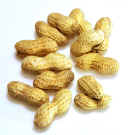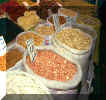 Peanuts Arachis
hypogaea
From South America; also called
ground nuts,
monkey
nut
and goobers.
Peanuts
are
planted
after
the
last
frost
in
April,
when
soil
temperatures
reach
65°
to
70°
Fahrenheit.
The
peanut
itself
is
also
the
seed.
Specially-grown
and
treated
peanut
kernels
from
the
previous
year's
crop
are
planted
two
inches
deep,
approximately
one
to two
inches
apart
in
rows.
Peanuts Arachis
hypogaea
From South America; also called
ground nuts,
monkey
nut
and goobers.
Peanuts
are
planted
after
the
last
frost
in
April,
when
soil
temperatures
reach
65°
to
70°
Fahrenheit.
The
peanut
itself
is
also
the
seed.
Specially-grown
and
treated
peanut
kernels
from
the
previous
year's
crop
are
planted
two
inches
deep,
approximately
one
to two
inches
apart
in
rows.
The
peanut
plant
is
unusual
because
it
flowers
above
the
ground,
but
fruits
below
the
ground.
Peanut
seeds
crack
the
soil
about
10
days
after
planting
and
grow
into
a
green
oval-leafed
plant
about
18
inches
tall.
Delicate
yellow
flowers
form
on
the
plant
about
40
days
after
planting.
The
flowers
pollinate
themselves,
then
the
petals
fall
off
as
the
peanut
ovary
begins
to
form.
This
budding
ovary,
called
a
"peg,"
grows
away
from
the
plant
on
a
vine
and
penetrates
the
soil.
There
are
four
basic
types
of
peanuts
grown
in
the
U.S.:
Runner,
Virginia,
Spanish
and
Valencia.
There
are
16,000
peanut
farms
in
nine
primary
growing
states
in
the
U.S.
These
are
operated
mostly
by
family
farmers
who
grow
an
average
of
98
acres
of
peanuts
each
year
on
a
3-year
rotation
usually
with
cotton,
corn,
soybeans
and
grass
crops.
Farmers
will
sell
their
peanuts
in
the
 domestic
market
for
about
31.5
cents
a
pound
in
1996
--a
5%
decrease
from
1995.*
domestic
market
for
about
31.5
cents
a
pound
in
1996
--a
5%
decrease
from
1995.*
Preparation
Peanut
shells break easily with the hands. The inner skin is edible,
but is also easily removed if desired. Peanuts are either fresh
or roasted if in the shells. Roast peanuts at 300° F. for
30 to 40 minutes in their shells, and 20 to 30 minutes after
shelling. Peanuts can be boiled in the shell to prepare them
for making peanut paste and similar recipes.
Market Forms
Peanuts
are available in the shell or shelled-fresh, roasted or roasted
and salted, loose or in packages.
Serve
themselves
for snacks, as peanut oil, peanut butter, in cookies, as an icing,
in confections and baking.
Complimentary Condiments and Flavors Chocolate, bacon, jellies and jams, marmalade, butter,
marshmallows, curries,
chicken,
pork.
*
Information
supplied
by
the
Peanut
Advisory
Board,
1025
Sugar
Pike
Way,
Canton,
GA
30115
 Peanuts Arachis
hypogaea
From South America; also called
ground nuts,
monkey
nut
and goobers.
Peanuts
are
planted
after
the
last
frost
in
April,
when
soil
temperatures
reach
65°
to
70°
Fahrenheit.
The
peanut
itself
is
also
the
seed.
Specially-grown
and
treated
peanut
kernels
from
the
previous
year's
crop
are
planted
two
inches
deep,
approximately
one
to two
inches
apart
in
rows.
Peanuts Arachis
hypogaea
From South America; also called
ground nuts,
monkey
nut
and goobers.
Peanuts
are
planted
after
the
last
frost
in
April,
when
soil
temperatures
reach
65°
to
70°
Fahrenheit.
The
peanut
itself
is
also
the
seed.
Specially-grown
and
treated
peanut
kernels
from
the
previous
year's
crop
are
planted
two
inches
deep,
approximately
one
to two
inches
apart
in
rows.